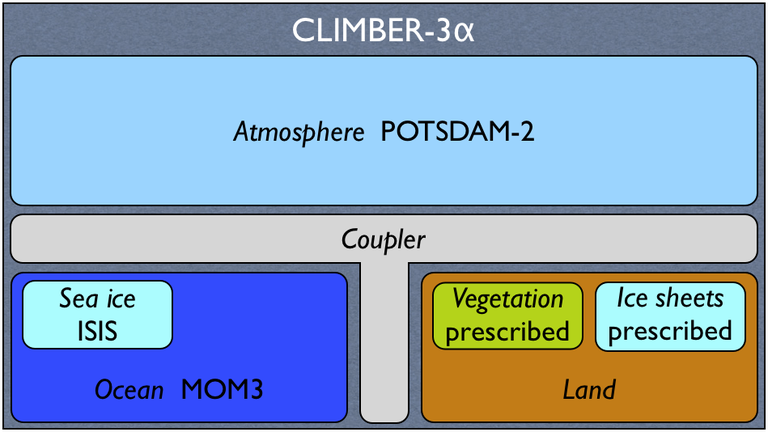Background
CLIMBER-3α is part of the suite of Earth System Models of Intermediate Complexity (EMICs) developed at PIK. EMICs attempt to overcome the gap between simple and comprehensive models by describing a considerable number of processes and feedbacks in the climate system, yet being computationally less expensive than comprehensive models due to their low spatial resolution and simplified governing equations. Typical pplications include studies in paleoclimate, anthropogenic climate change, and model uncertainty analysis.
CLIMBER-3α has evolved from the highly successful CLIMBER-2 model. The main difference with respect to CLIMBER-2 is the ocean component, which has been replaced by a state-of-the art ocean model including an ocean general circulation model (OGCM), a biogeochemistry module and a state-of-the-art sea-ice model. The atmospheric resolution was slightly increased as compared to CLIMBER-2. Thus, CLIMBER-3α includes modules describing the atmosphere, land-surface scheme, ocean, sea-ice, and marine biogeochemistry.
Due to its relatively simple atmospheric component it is approximately two orders of magnitude faster than coupled AOGCMs, allowing the integration of a much larger number of integrations and sensitivity studies, as well as longer simulations. At the same time its oceanic component confers to it a larger degree of realism compared to those EMICs which include zonally averaged oceanic components. The model is thus suited for large-scale climate dynamics with a special focus on the ocean dynamics.
Scheme

The Ocean Model - MOM3
The Atmospheric Model - POTSDAM 2
The Sea-Ice model - ISIS
Coupling
Model development team
- Andrey Ganopolski
- Matthias Hofmann
- Anders Levermann
- Miguel A. Morales Maqueda (CIMS, New York, USA)
- Juliette Mignot (LOCEAN, Paris, France)
- Marisa Montoya (UCM, Madrid, Spain)
- Vladimir Petoukhov
- Stefan Rahmstorf
Application
Over the years, the CLIMBER-3α model has been successfully used in a wide range of science applications.
References





